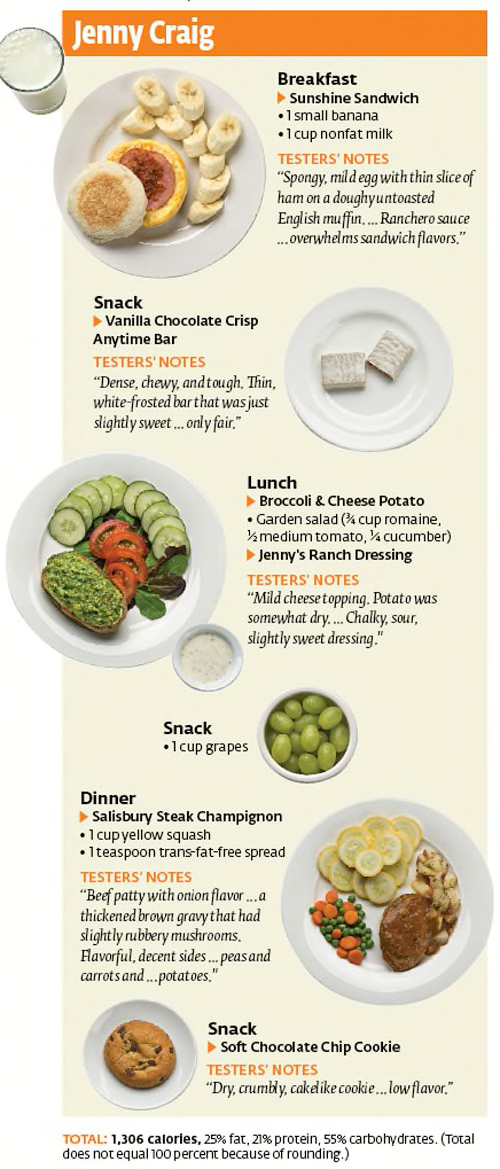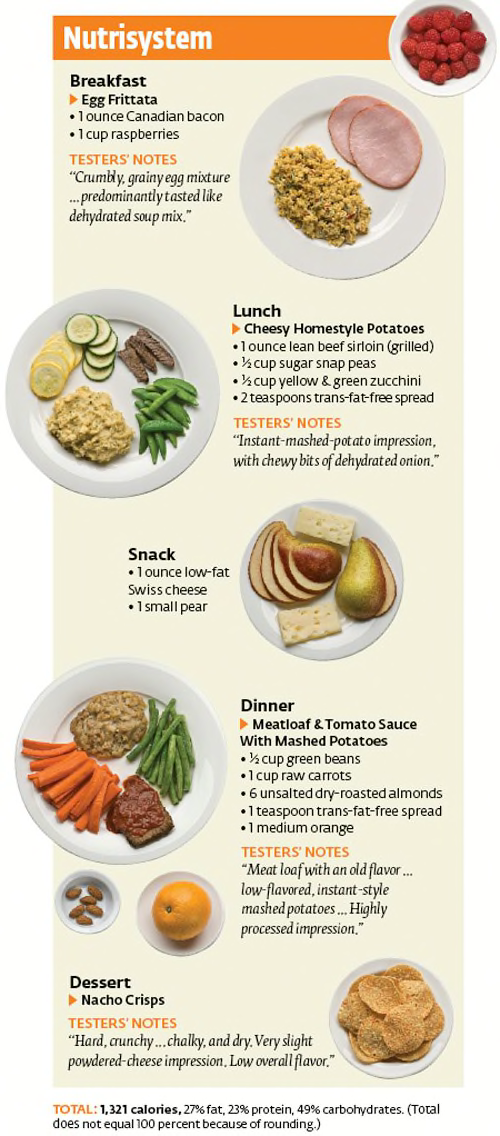s diet gurus never stop advising (and our own reader surveys confirm), portion control is the magic bullet that successful losers use to slough off the pounds and keep them off. So much so, in fact, that it’s part of the basic business plan of Jenny Craig and Nutrisystem (results available to subscribers), two of the top U.S. commercial diet plans.
Jenny Craig and Nutrisystem sell plan members branded, packaged entrées, snacks, and desserts, which members then supplement with store-bought fresh fruits, vegetables, and dairy products. We’ve often wondered how those companies’ meals-in-a-box compare with each other in terms of taste.
And now we know. We joined both programs, obtained menus, and ordered foods. Our tests of a week’s worth of food from the companies found that when it came to taste, Jenny Craig edged out Nutrisystem.
But not by a large margin: Jenny Craig’s food scored in the high end of the Good range compared with the low end of Good for its rival. (To our taste testers, “good” means OK but not great.)
Our bottom line for taste is that the plans might be worth trying if you’re willing to stick with their branded foods. But you can achieve the same portion control with diet meals and entrées from the supermarket freezer case that may be tastier. (We didn’t test Weight Watchers foods because they’re not a required part of the program and anyone can buy them in grocery stores.)
How the plans work
Jenny Craig and Nutrisystem give you meal plans that include their branded foods. The programs have websites where you can track your progress, get tips for diet and exercise, and interact with trained consultants and fellow dieters.
With Jenny Craig, you pay a program fee that entitles you to weekly one-on-one counseling by telephone or at a walk-in center. We paid $20 to lose 20 pounds in 10 weeks, though introductory deals vary from time to time. If you want to continue after your initial program runs out (whether or not you’ve lost the weight), you pay an additional fee. You can pick up your food at the center or have it delivered to your home.
Nutrisystem has no walk-in locations but provides optional online and phone support at no additional charge. Food is delivered to your home.
We paid $300 for four weeks of meals on the Nutrisystem Basic plan, shipping included. It’s the company’s most popular option; all of the plan’s meals are shelf-stable, which means they don’t require refrigeration. We paid $264, plus $65 shipping, for two weeks of Jenny Craig meals from its At Home menu. The meals were a mixture of frozen and shelf-stable items. We didn’t evaluate the cost of the home-supplied items on the plans’ menus.
Are they worth trying?
The best diet for you is the one you can stick to. These programs might appeal to people who have trouble with meal planning, have limited time and skill for cooking at home, struggle with portion control, or feel they might benefit from community support and counseling.
If you don’t like the restricted choice of the programs, you can devise a homemade version using frozen diet meals from the supermarket. Our previous tests of diet meals have found many that are tasty and nutritious.
Taste-test results of Jenny Craig and Nutrisystem

Two experienced sensory testers tasted, in total, 32 Jenny Craig products and 27 Nutrisystem Basic products. Where possible, we chose similar items. We also conducted a side test of six frozen entrées from Nutrisystem’s more expensive Select line.
The products were tasted in random order within categories—breakfasts with breakfasts, snacks with snacks, and so on. Our tasters not only didn’t know whose product they were tasting but also didn’t know they were diet meals.
Of the 59 items we tasted in our main round of tests, only five scored Very Good—all from Jenny Craig. Of the 10 items we deemed Fair, eight were from Nutrisystem. Overall, the foods from Jenny Craig did slightly better than Nutrisystem’s.
Jenny Craig’s edge came mainly from its lunch and dinner entrées, most of which were frozen rather than shelf-stable. The frozen Nutrisystem Select dinner entrées we tested fared much better than the company’s shelf-stable items. (After we completed our testing, a company spokeswoman told us that Nutrisystem’s standard 28-day program would change at the end of 2010. The standard 28-day program now consists of 10 days of frozen foods and 18 days of pantry-ready foods.)



